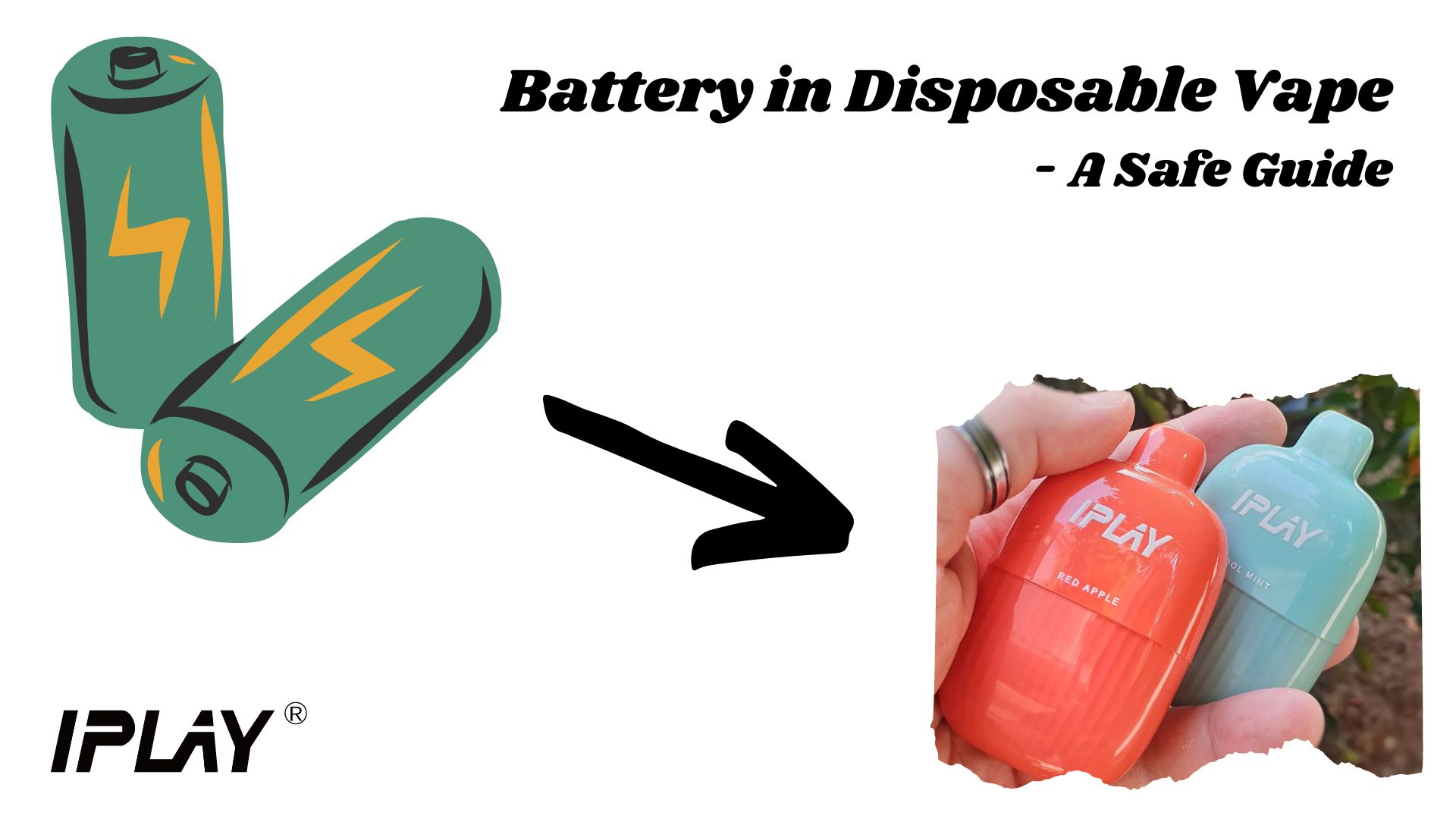As the popularity of vaping continues to rise, so does the demand for disposable vape devices. These compact and convenient devices have become a go-to choice for many vapers due to their ease of use and portability. However, while disposable vapes may seem simple, it’s crucial to understand the battery inside them and the safety measures associated with their usage. For a better and safer vaping experience, let’s delve into the article and see what should we take caution.

Part One – Understanding the Battery in Disposable Vapes
Disposable vapes typically use one-time, non-rechargeable batteries that are integrated into the device’s design. Unlike traditional vape mods or pod systems, disposable vapes lack the option to recharge the battery, which means vapers can enjoy them until the battery is depleted, after which the entire device is discarded. As the vaping industry continues to evolve, some manufacturers have introduced rechargeable disposable vapes that offer a sustainable alternative to traditional one-time use devices, reducing waste and environmental impact. However, it’s important to note that even in rechargeable disposable vapes, the batteries are not user-replaceable, meaning vapers still need to discard the entire device once the battery reaches the end of its lifespan.
1. Types of Batteries Used in Disposable Vapes
Disposable vapes commonly use lithium-based batteries, primarily Lithium-ion (Li-ion) or Lithium-polymer (Li-po) batteries. These batteries are chosen for their high energy density, compact size, and lightweight properties, making them ideal for use in portable vaping devices. The specific type of battery used can vary between different brands and models of disposable vapes, but both Li-ion and Li-po batteries offer reliable power for the duration of the device’s lifespan.
2. Battery Capacity and Power Output
The battery capacity of disposable vapes varies depending on the size of the device and the intended duration of use. Manufacturers typically design disposable vapes with different battery capacities to meet the needs of various vapers. Higher battery capacity allows for longer vaping sessions before the device runs out of power. When choosing a disposable vape, vapers may find information about the battery capacity (usually measured in milliampere-hours or mAh) on the packaging or in the product specifications.
The power output of a disposable vape battery plays a crucial role in determining the vaping experience. It affects factors such as vapor production, throat hit, and the overall intensity of the flavor. Manufacturers carefully calibrate the power output of the battery to ensure a satisfying and consistent vaping experience throughout the device’s usage.
3. How the Battery Enables the Functioning of the Device
The battery is the heart of a disposable vape, providing the electrical energy required to heat the e-liquid and create vapor. How do disposable vapes work? When a user takes a puff, the battery activates the heating element, known as the coil, which in turn vaporizes the e-liquid contained in the disposable vape. The generated vapor is then inhaled by the user, delivering the desired nicotine or flavor experience.
The simplicity of disposable vapes lies in their automatic activation mechanism, meaning they do not require any buttons to initiate the vaping process. Instead, the battery is designed to be draw-activated, activating the coil when the user takes a puff from the mouthpiece. This automatic activation makes disposable vapes incredibly user-friendly, as there is no need to press any buttons to start vaping. Knowing some safety tips of batteries employed in disposable vapes is crucial, while improper usage will cause damage to the device itself, even resulting in a dangerous explosion of vape.
Part Two – Risks Associated with Disposable Vape Batteries
1. Overheating
Overheating is a significant risk associated with disposable vape batteries, especially when the device is subjected to excessive use or exposure to high temperatures. When a disposable vape is continuously used for an extended period, the battery may heat up significantly, leading to potential hazards. The most concerning consequence of overheating is the possibility of the battery catching fire or even exploding. Additionally, overheating can negatively affect the device’s overall performance, leading to a reduction in battery life and subpar vapor production. It is crucial for vapers to be cautious and avoid prolonged, intensive vaping sessions to prevent overheating incidents.
2. Short Circuits
Short circuits pose another risk to disposable vape batteries. A short circuit occurs when the positive and negative terminals of the battery come into direct contact, bypassing the normal electrical pathways. This can happen due to a damaged coil, improper handling, or even a malfunction in the device itself. When a short circuit occurs, an excessive amount of current flows through the battery, causing rapid heat generation and potentially leading to battery failure or thermal runaway. Disposable vape users should avoid using damaged devices or coils and ensure that their devices are well-maintained to prevent short circuit incidents.
3. Impact of Physical Damage on Battery Safety
Disposable vapes are compact and often carried in pockets or bags, making them susceptible to physical damage. Dropping or mishandling the device can cause damage to the battery and other internal components, compromising its safety. A damaged battery may leak hazardous materials or become unstable, posing a safety risk to the user. To mitigate this risk, vapers should handle their disposable vapes with care, avoid subjecting them to unnecessary impacts, and consider using protective cases to shield the device from potential damage.
4. Prolonged Storage and its Effects on Battery Performance
Leaving a disposable vape unused for an extended period can negatively impact battery performance and safety. Batteries have a self-discharge rate, and over time, they may lose charge even when not in use. If a disposable vape is stored for an extended period with a fully depleted battery, it could lead to complete discharge and potentially render the device unusable. Moreover, prolonged storage in unsuitable conditions, such as extreme temperatures or high humidity, can further degrade the battery’s performance and safety. To ensure optimal performance, vapers should store their disposable vapes in a cool, dry place and avoid leaving them unused for prolonged periods.

Part Three – Safety Tips for Using Disposable Vapes
1. Buying from Reputable Brands
When purchasing disposable vapes, always opt for products from reputable and well-established brands. Reputable brands prioritize safety and quality control in their manufacturing process, ensuring that their products meet industry standards and regulatory requirements. By choosing trusted brands, vapers can have greater confidence in the safety and reliability of the disposable vape they are using.
IPLAY is one of the trusted brands to which you can lend credibility. With strict rules and monitoring in the manufacturing process, IPLAY’s products garner a great reputation for its quality, ensuring a safer vaping journey for customers.
2. Proper Storage Practices
Proper storage is crucial for maintaining the integrity of disposable vapes and their batteries. When not in use, store the device in a cool, dry place, away from direct sunlight and extreme temperatures. Avoid leaving the disposable vape in hot cars or freezing conditions, as this can affect the battery’s performance and longevity.
3. Avoiding Overcharging
For rechargeable disposable vapes, avoid overcharging the battery. Overcharging can lead to excessive heat generation and put unnecessary strain on the battery, potentially reducing its lifespan. Always follow the manufacturer’s recommendations for charging times and never leave the device plugged in for longer than necessary.
Taking IPLAY X-BOX as an outstanding example. The device employs the latest lithium-ion battery that runs electricity smoothly. When the battery dies out, X-BOX offers a rechargeable option – what users need is to plug in a type-C charging cable and wait. When the battery is fully charged, the indicating light on the bottom will be off, providing users with a clear sign of proper charging.

4. Checking for Physical Damage
Before using a disposable vape, thoroughly inspect the device for any signs of physical damage. Look for cracks, dents, or any other visible issues with the battery or the outer casing. Using a damaged device can lead to battery leaks, short circuits, or other safety hazards. If any damage is detected, refrain from using the device and consider disposing of it responsibly.
5. Responsible Disposal Methods
At the end of its lifespan, dispose of the disposable vape responsibly, following local regulations and guidelines for electronic waste. The device contains potentially hazardous materials, including the battery, and should not be thrown into regular trash bins. Check with your local waste disposal facilities or electronic recycling centers for appropriate disposal methods. Ensuring an environmentally friendly vaping world is crucial to create a green world and guarantee a sustainable development of the industry.
6. Keeping the Device Away from Water
Disposable vapes and water don’t mix well. Keep the device away from water, and avoid exposing it to any liquids. Water can damage the battery and other electronic components, leading to malfunctions or total failure of the device. If the disposable vape accidentally comes into contact with liquid, do not use it and seek a replacement immediately.
7. Avoiding Modifications
Disposable vapes are designed for easy, hassle-free use. Avoid attempting to modify the device or its components in any way. Modifying the battery, coil, or other parts of the disposable vape can compromise its safety and lead to unpredictable and potentially dangerous consequences. Stick to using the device as intended by the manufacturer.
Conclusion:
In conclusion, understanding the battery in a disposable vape is crucial for a safe and enjoyable vaping experience. By recognizing the risks associated with these batteries and following essential safety tips, vapers can minimize potential hazards and maximize their satisfaction with disposable vape devices. Always prioritize safety, purchase from reputable brands, and handle the battery with care to ensure a safe journey in the world of vaping. Happy vaping!
Post time: Aug-03-2023

